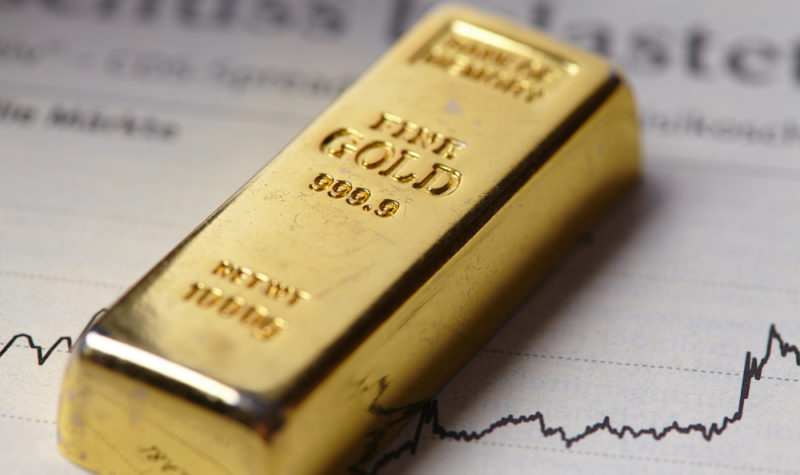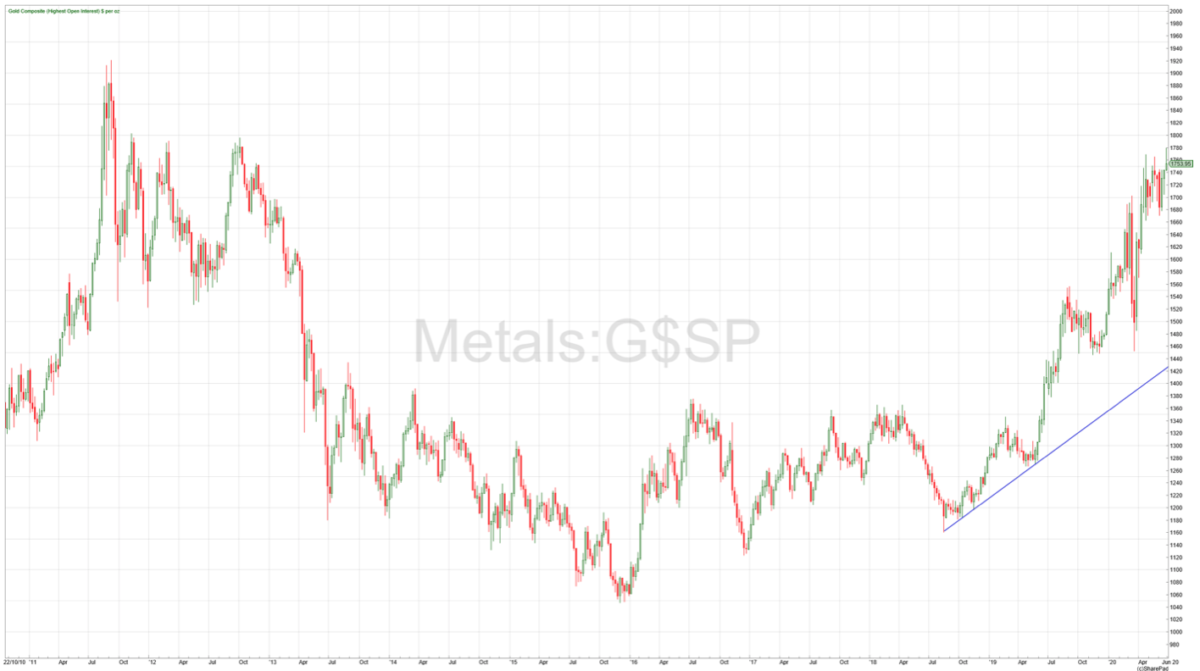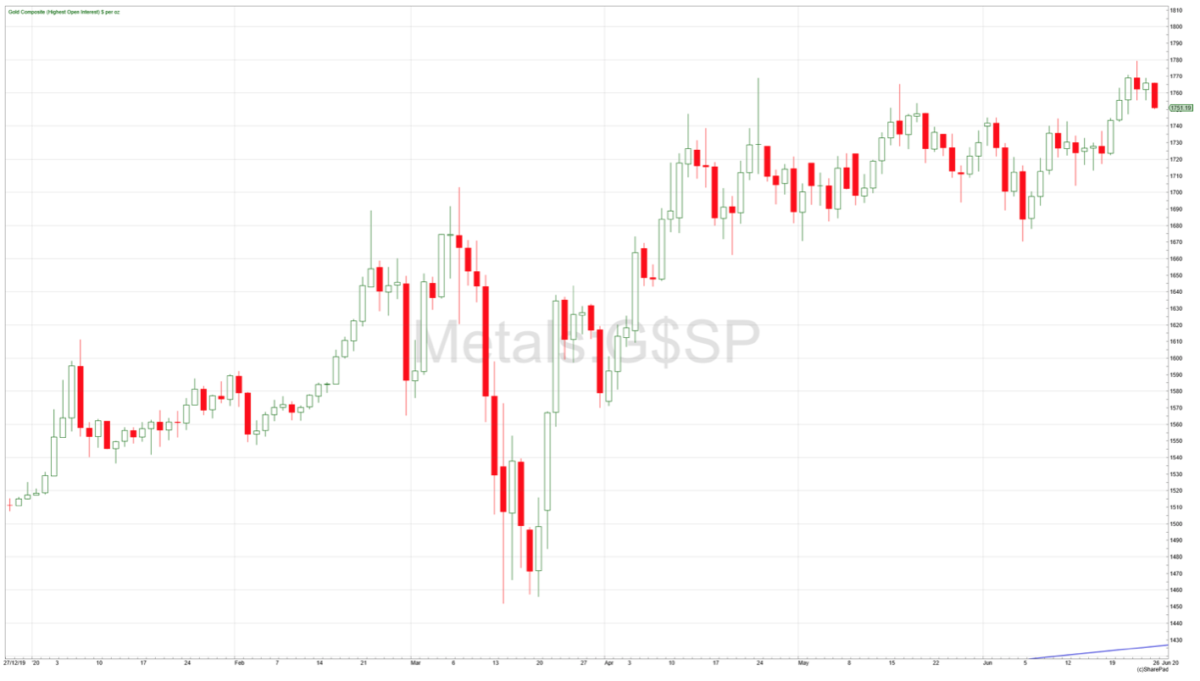Trading gold – and avoiding common mistakes

The shorter-term chart for gold shows the breakout to fresh seven-year highs. It can also be seen that $1,660 provided good support for gold through all of April and May, writes David Jones.
When it comes to spread betting, one of the most often quoted benefits is that any profits are tax-free. This is perfectly true of course – but given that most traders end up losing, it can be of little consequence to most of us. So what can we do to try to make our own outcomes a little more positive?
Why do most traders lose?
Following changes by the regulators, trading brokers now have to display on their website the percentage of clients who lose money, eg “76% of retail traders lose money when trading spread bets with this provider”. That is hardly a catchy marketing hook. But it does drill home just how hard trading is, and how slim the chances are of ending up with a gold-plated Lamborghini by Christmas.
A plus of spread betting is the sheer breadth of markets you have at your fingertips. This means that if for example, stock markets are not moving, then perhaps there is something happening in foreign exchange, or in commodities such as cocoa. You could say that this just gives people more opportunity to lose money – but we will review here a market that looks interesting – and discuss some common pitfalls of losing traders, as well as ways of avoiding them.
If most people are losing, is there a common theme as to why this is? I have worked in the retail trading business for the best part of 20 years and I think there are a few points that crop up time and again.
Too short term
The leaps we have seen in technology since the dot.com-bubble days means that we now have real-time price data on any device, anywhere in the world, for virtually any market. The lure of the flash of changing prices should not be underestimated − indeed, I am as guilty as anyone else of losing minutes and sometimes hours watching prices change. And this has contributed to many of us taking far too short term a view on trades. In fact, it affects longer-term investors too, with the average holding period amongst US investors dropping drastically over the years this century. So, I think the first lesson is not to get too hung up on where a market may be going in the next five minutes, two hours – or even couple of days. You may be right on the market direction overall, but what are the chances that you have nailed the perfect entry point to the second? There is a lot to be said for placing a stop-loss and then not obsessively watching your position.
Lack of risk controls
The use of leverage in products such as spread betting, contracts for difference and futures means it is possible to make a lot of money very quickly. And of course, ‘as any fule kno’, that must mean that you can lose a lot of money very quickly too. As an investor over the years, sticking your head in the sand and grimly holding on when markets are tanking has generally speaking worked out okay – just take a look at the NASDAQ moving to fresh all-time highs in recent days. Using this approach with leveraged products is normally not going to end so well. It is important to manage risk when trading using spread bets. It does not mean you have to bail at the first sign of trouble – remember, your entry position is highly unlikely to accurately nail the turn in the market – but do have a level where you decide you were wrong and move on to something else.
We will use both of these approaches in this month’s trading idea.
Gold hits seven-year high – more to come?
The gold price has been interesting this year – plenty of volatility over the spread of the coronavirus pandemic and, in recent weeks, it has settled back into more calmer trading day-to-day, pushing out to its best levels since 2012.
10-year gold-price chart

Broadly speaking, the price of gold has been moving higher for the best part of two years. The latest major bottom was in August 2018 when it traded as low as $1,160 an ounce. Towards the end of June, it was trading at $1,750 – notching up gains of around 15% for the year to date.
Normally viewed as a safe haven in times of trouble, this old maxim did not play out in March of this year as investors panicked about the worldwide pandemic. Gold was hit hard as the US dollar became the destination of choice for those looking to reduce their risk exposure. There then followed some strong gains as the US dollar weakened and a certain type of physical gold faced a shortage. Due to the coronavirus, three major gold refiners in Switzerland were closed due to the lockdown. Suddenly there was a lack of physical gold, resulting in some confusion and lack of liquidity. Since then, the market has gone back to a more normal state and briefly set that fresh seven-year high on 24 June.
Why is gold rising?
It has been a volatile year for the yellow metal but the path of least resistance is still up.
Gold price in 2020

After the volatility in March, it can be seen that gold has still continued to drift higher, albeit with a lot less day-to-day drama. I think there are at least two obvious reasons behind the recent rise in gold.
Rightly, there are still some concerns amongst investors for the economic outlook, post pandemic. The recovery in stock markets from their March lows has been nothing short of stunning. As mentioned above, the NASDAQ 100 index – the tech-biased benchmark – actually set fresh all-time highs in June. Of course, we all need to remember that the stock market is not the economy, but some investors are perhaps concerned that as economies very slowly move back to a new normal, there could be a degree of complacency and they are using gold to hedge that risk.
The other factor is the US dollar. Normally, the price of gold will move in the opposite direction to that of the dollar. In this way we can think of the gold price as another type of currency pair. In the same way that if the dollar falls then the pound goes up, the same is true of gold. The spread of the coronavirus saw plenty of economic support from governments and central banks – and the US was no exception. Its own central bank, the Federal Reserve, dropped its interest rate to zero. In addition, it has said that it expects low rates to persist through 2022 to help support economic recovery. This has put some pressure on the US dollar over the last month, which has helped to keep the gold price well-supported.
How to spread bet on gold
When it comes to spread betting on gold, it is like any other market. There is a two-way price – the spread – and you just decide to buy or sell, and how many pounds per point. When taking a longer-term position, the futures spread bet can be more cost effective, as the cost of financing is already built into the price. At the time of writing the Gold August futures spread bet price was $1,760/$1,760.5
The other consideration is where to put a stop-loss – for me, always a crucial part of managing risk when trading. The shorter-term chart may help here.
Gold price April 2020 to present

The shorter-term chart here shows the breakout to fresh seven-year highs at the far right-hand side of the chart. It can also be seen that $1,660 provided good support for gold through all of April and May. Having a stop-loss the other side of $1,660 would be a very conservative stop for the trader looking for a bigger swing in gold. A tighter or more aggressive stop-loss could be placed below $1,700 for example.
Breakouts like these can be hard to trade – it is rare that a market takes off in the direction of the breakout as soon as it happens – and there are of course such things as false breakouts. But in this example, we are avoiding two ‘rookie’ approaches to trading. The trade idea is not short term and if gold progresses in the direction of the breakout then this is a position I would be happy to run for weeks and even months. Plus, the all-important risk control is in place, and not set too tightly. This frees us up from having to watch the market around the clock and should make for a slightly more relaxed and more disciplined style of spread betting.
David, you are a recognised expert on TA, a subject which I am familiar with and which I find fascinating. It does provide an edge but not as great as many suppose. It is human optimism that persuades novices that expert knowledge of brain surgery can be acquired overnight. Why else would so many lose in the simple business of spread betting? It took me a long time to recognise that discipline is essential and for me the boring matter of scrupulous book-keeping and in-depth analysis of failed trades has helped immensely.
On trading precious metals which I have been doing for more than a decade I would respectfully suggest that you place too much emphasis on Covid. The true state of the markets and the bull market in precious metals pre-dates it and there is unlikely to be a normal for a very long time.
At a practical level the key to strength in the PMs is REAL interest rates, and not so much what level they are at, but whether they are rising or falling. The dollar is also important but the gold/dollar correlation doesn’t always hold. On stop losses with PMs and commodities I only use them about 25-30% of the time because the volatility and spikes take out too many positions unnecessarily.
Enjoyed reading the spread bet procedure. Very formative and will study the notes again before deciding ifto participate.
Thank you